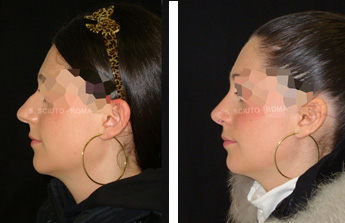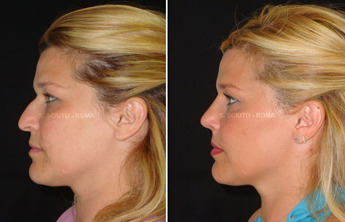
My primary rhinoplasty
"The most successful plastic surgery is not seen on the face but felt in the spirit." This is the dictum of the celebrated Brazilian surgeon Ivo Pitanguy, one of the recognized fathers of modern plastic surgery.
As regards the nose in particular, I would add this personal observation of my own: "I don't like phony noses."
Just as I don't like oversized lips, protruding cheekbones and cheeks pulled too tight.
My aim in primary rhinoplasty is to obtain a natural and "non-surgical" appearance, and I always seek to achieve this by taking a conservative approach so as to ensure the functional integrity of the nose. I am convinced of the need to avoid aggressive maneuvers capable of undermining the supporting structures. In this way, the nose will remain stable over time and keep the right shape after the process of scar formation is completed.
Rhinoplasty has evolved over the years, not least in response to trends of the moment, like fashion. While women wanted upturned noses with a slightly concave ridge in the 1960s and '70s, the trend in the more recent past was for straighter noses with a sharply defined tip. The ideal nose today is different for every individual but with the primary requisite of being nothing like what was for years the typical "nose job" look.
Successful rhinoplasty is based on vast knowledge and experience built up over the years together with surgical skill and prudence combined with a certain degree of talent. All this will not produce the desired result, however, if an understanding is not reached between surgeon and patient. The reason why computer simulations are developed during the preoperative examination is not so much to show what the nose will look like after the operation as to ensure both that the surgeon understands what the patient wants and that the patient understands what the surgeon can (and cannot) do.
Every patient should be aware that rhinoplasty is an authentic surgical operation and that healing takes time, a long time in some cases. Patients who undergo rhinoplasty, and especially young ladies, often hope that they will be able to show off their new nose just two or three weeks after the operation. They are quite wrong. It is only after two or three months that you can have some idea of the nose's final appearance, which will emerge in the space of about a year. That will be the definitive and lasting result.
If an excessively concave, pinched or upturned nose can prove unattractive in a woman, it becomes disastrous in a man. A man's nose must be precisely that. While always respecting the patient's wishes, even more care must be taken in male rhinoplasty to avoid any distortion of nasal characteristics. The worst possible thing would be to take a nose from another face and "stick it on" in place of your own. A successful operation on a man should leave the same nose but without the flaws.

Primary rhinoplasty. Postoperative and preoperative photographs. Check after one year.

Primary rhinoplasty. Left: preoperative photograph. Center: check after 6 months.
Right: permanent result in a check carried out after 16 years.

Primary rhinoplasty. Left: preoperative photograph. Center: preoperative computer simulation. Right: actual postoperative result

Male primary rhinoplasty. Preoperative and postoperative photographs. The patient
attached the utmost importance to maintaining the masculine appearance of the nose.

To perform a rhinoplasty is never simply to remove: in this case the right balance in removal of the hump and increasing of the radix of the nose determines the desired profile.